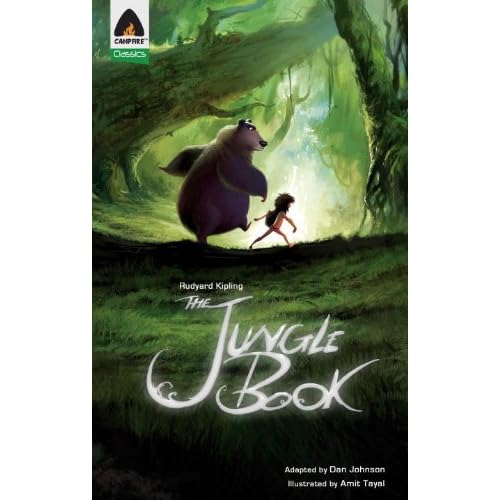 For a comic book, its visual design is superb. Campfire’s latest adaptation, Rudyard Kipling’s classic The Jungle Book, is absolutely gorgeous: it’s not in the same playing field as popular superhero comics by DC and Marvel, that’s for sure. (Feel free to disagree, but neither Spiderman nor Green Lantern has ever been drawn so crisply or in colors so rich.) Children will love the drawings and parents will appreciate Campfire’s mission to make classics of literature (and other stories of historical, mythological, and biographical import) compelling for reluctant readers. Many publishers are adapting classics of literature for the comic book medium to engage young readers. I’ve seen the graphic adaptations in bookstores and on library shelves and I’ve yet to see one so compelling, fresh, and fun. It’s hard not to connect with a story when it looks flat-out beautiful. And it must be stated that the size of the book, slim and light, helps too.
For a comic book, its visual design is superb. Campfire’s latest adaptation, Rudyard Kipling’s classic The Jungle Book, is absolutely gorgeous: it’s not in the same playing field as popular superhero comics by DC and Marvel, that’s for sure. (Feel free to disagree, but neither Spiderman nor Green Lantern has ever been drawn so crisply or in colors so rich.) Children will love the drawings and parents will appreciate Campfire’s mission to make classics of literature (and other stories of historical, mythological, and biographical import) compelling for reluctant readers. Many publishers are adapting classics of literature for the comic book medium to engage young readers. I’ve seen the graphic adaptations in bookstores and on library shelves and I’ve yet to see one so compelling, fresh, and fun. It’s hard not to connect with a story when it looks flat-out beautiful. And it must be stated that the size of the book, slim and light, helps too.
Every page of Campfire’s The Jungle Book contains vivid and colorful illustrations. Frankly, it’s a refreshing change from many of its digital counterparts. I find graphic novels in e-format unappealing because, by zooming in on each panel to read the text, you lose the emotional effect of the whole. The physical book in hand, Campfire’s The Jungle Book captivates readers through art and design. The lush colors of the forest, the murky and inky greens and browns in stark contrast to the inky purple of panther pelt and bright orange of tiger fur, make the cute, cartoony animals made iconic by Disney flat by contrast and, well, horrifically two-dimensional. Mowgli is drawn sharp, his lanky human limbs threatening, during high tension, passionate scenes. When he is playful and adventurous, learning the rules of the jungle with Baloo, he is drawn softer and rounder to emphasize his youth and naïveté. The scheming monkeys are eerie and manic. Shere Khan and his gang of jackals look malicious, even blood-thirsty. The humans look fragile yet cold and unwelcoming; a tribe all of their own, on their own.
I will say that as an adult reader the writing was a tad disappointing, though it is more poetic than the Disney version. The language is truer to Kipling’s prose but the translation is not entirely cohesive. Several scenes don’t transition well, such as when Mowgli leaves the jungle to live among the humans. Plus, I was put off by how awkward and stiff the language was for between the wolves and Shere Khan. In all, the story could have been better developed. If the series is in fact “inspired by [an] enduring relationship between a campfire and gripping storytelling,” for me it fell a bit short. I was captivated by the illustrations, the graphic rendering of the tale, but not by the narrative arc.
The Campfire adaption of The Jungle Book will definitely satisfy young minds – particularly those who are reluctant readers – but it also should be left to them. If you are a young or adult reader seeking a more complex and developed narrative, stick to the original Kipling. And, let’s be real, how can you surpass a classic? More importantly, perhaps, who would want to?
